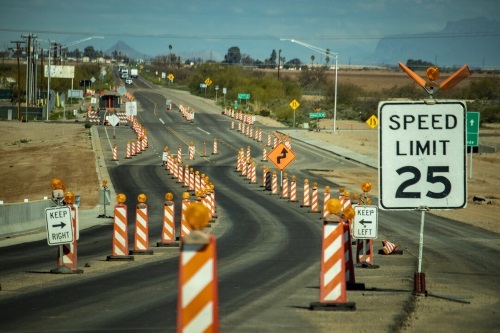The Federal Highway Administration and state departments of transportation across the country participated in a variety of events designed to support National Work Zone Awareness Week, held April 26-30.
[Above photo by the Arizona DOT]
The FHWA noted that 842 people died in highway work zone crashes in 2019 – the most recent year for which data are available compared to 757 in 2018. That 11.2-percent increase is the largest percentage increase in highway work zone fatalities since 2006, the agency added.

“We all have a role to play when it comes to safely repairing and improving our nation’s roads, bridges and highways,” emphasized Stephanie Pollack, FHWA’s acting administrator, in a statement. “If you are driving and see construction work ahead – and especially workers on the job – please slow down and drive carefully.”
The agency noted that crashes in highway work zones happen most frequently when drivers are not paying attention to changing road conditions. Though highway workers are often among the victims of work zone crashes, the dangers of such distracted driving more often affect those behind the wheel and their passengers, FHWA said, as four out of five work zone fatalities are drivers or passengers.
“The men and women fixing our nation’s highways deserve to get to work, do their job and return home safe and sound after their shift,” Pollack said. “They can’t work safely if you don’t drive safely.”
State DOT executives across the country echoed her comments.
“Safety is our top priority, which is why we take Work Zone Awareness Week seriously each year and enthusiastically participate,” explained Secretary Shawn Wilson, Ph.D., secretary of the Louisiana Department of Transportation and Development, in a statement.

“With all of the investment that we have in this state, as well as in this country, work zones are a very common place, so our message to the traveling public is always the same: slow down, avoid distractions in the vehicle, and be alert for work crew,” he added.
Wilson – who also services as the 2020-2021 vice president for the American Association of State Highway and Transportation Officials – added that his department is offering a “robust agenda” to state legislators focused on safety.
“Going forward, we have to have policies and practices that prioritize safety, embrace innovation, apply technological advances, and implemented in a timely fashion to benefit all travelers,” he noted.

“We put safety first when establishing work zones … to ensure workers and drivers have enough space to safely navigate through a work zone,” explained John Halikowski, director of the Arizona Department of Transportation, in a blog post.
“Besides our transportation crews, we have first responders like law enforcement, firefighters and tow truck operators who also need a safe area to work,” he added.
To emphasize the human toll of work zone crashes, agencies such as the Minnesota Department of Transportation and the South Carolina Department of Transportation conducted memorial services for employees killed on the job in work zone incidents.

“[The] tragic loss of life that happens each year in work zones can be avoided,” said Allison Green, the Drive Safe Alabama coordinator for the Alabama Department of Transportation, in a statement.
“Just move over and slow down, so that those working along the roadway and you and your passengers can all get home safely,” she said.
“Together, we stand united with every one of our colleagues … who puts themselves in harm’s way when they go to work on Connecticut’s highways and roadways,” noted Joe Giulietti, commissioner of the Connecticut Department of Transportation, in a statement.
“The Connecticut DOT has a job to do [so] let our people – the best in the business – do it,” he added. “I’m calling on all of Connecticut’s motorists, please drive safe, slow down, move over, and obey the orange and you can truly save lives.”
 Top Stories
Top Stories
Collaboration Touted at AASHTO’s Third Safety Summit
October 31, 2025 Top Stories
Top Stories

